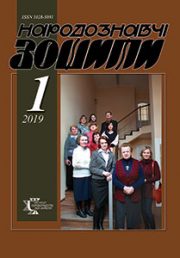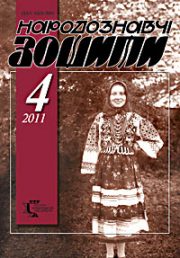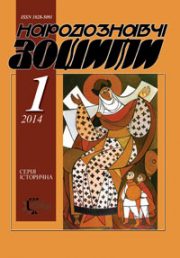The Ethnology Notebooks. 2019, № 6 (150), 1510—1516
UDK271.2 – 523.47: 7.021.7](477.8)”185″
DOI https://doi.org/10.15407/nz2019.06.1510
TYPOLOGY OF ICONOSTASIS OF THE EAST OPILLIA СHURCHES IN THE MIDDLE OF THE 19TH CENTURY
BAKOVYCH Olena
ORCID ID: http://orcid.org/0000-0003-2524-0863
Ph.D. lecturer, department of sacred art,
Lviv National Academy of Arts
38, Kubiiovycha Street, 79011, Lviv, Ukraine
e-mail: olena.bakovych@lnam.edu.ua
Abstract. Introduction. In the course of its development, the Ukrainian iconostasis undergoes various stages of development. Not all regions had these processes taking place at the same time and thus may have some differences caused by geographical, historical, social and cultural factors. One of such territories is East Opillia. The iconostasis of the churches of this region had peculiarities in the constructive and plastic decorative solution. The peculiarities of such iconostases are a decrease in the number of decorative carvings compared to the previous period and an increase in attention to the composition of design solutions. The purpose of the article is to systematize and propose a typological classification of iconostases.
The methodological basis of the article is a formal analysis combined with empirical research methods. As a result, according to structural features of the iconostasis of the churches of the East Opillia of the 19th century are divided into three types: low — single-tier, multi-tier divided into two parts above the upper tier, multi-tier as a solid wall, but with a gap between the upper tier and the Feasts tier. The first type includes iconostasis consisting only of an upper tier, sometimes with a basement. The second type includes iconostases, which are composed of two parts and open an overview of the Sanctuary. In such constructions, the upper tier can be connected at the edges with the Apostolic one, or the upper part of the iconostasis (Feasts, Apostolic, Prophetic tier) may be a separate structure, which is attached to the eastern wall of the vestibule. The gap of this type of arch-shaped iconostasis can be decorated with bows or drapes with drones and tassels. Due to the location of the upper tiers in the shape of an arch, the straightness of an upper part of the composition is lost. The third type most preserves the traditions of Ukrainian iconostasis construction of previous periods.
Conclusion. Despite the possibility of a typology of iconostases according to certain features, each of them is a unique and inimitable monument.
Keywords: Deacon’s Doors, iconostasis, decorative carving, construction, composition, Holy Door, tier.
Received 28.11.2019
REFERENCES
Kunevych, B., & Stotskyj, Ya. (Eds.). (2014). Ternopil-Zborivska archdiocese. Parishes, monasteries, churches. Schematism. Ternopil: Novyj kolir [in Ukrainian].
Drahan, M. (1970). Ukrainian decorative carving ХVI-th—ХVIII-th centuries. Kyiv: Naukova dumka [in Ukrainian].
Taranuschenko, S. (1994). Iconography of Ukrainian iconostases. Kharkiv [in Ukrainian].
Taranuschenko, S. (1994). Ukrainian iconostasis. The NTSh`s notebooks. Works of the section of art history, 227 (ССХХVII), 141—164 [in Ukrainian].
Hrabar, Y. (1966). About the art or Ancient Rus. Moscow: Nauka [in Russian].
Uspenskyj, L.A. (1998). The guestion about iconostasis. The orthodox icon. The canon of the style (Pp. 223—255). Moscow: Pravoslavnyj palomnyk; Hlaholy zhyzny [in Russian].
Florenskyj, P. (1993). Iconostasis. Selected works of art. SPb.: Myfryl-Russkaia knyha [in Russian].
Yarema, V. (1959). The origin and development of our Orthodox iconostasis. The Orthodox bulletin, 10, 309—316 [in Ukrainian].
Yarema, D. (1961). Traditions and innovations in the construction of iconostases of the XVII-th and XVIII-th centuries in western Ukraine regions. The Orthodox bulletin, 5—6, 117—190 [in Ukrainian].
Zholtovskyj, P.M. (1983). Artistic life in Ukraine in the XVI-th—XVIII-th centuries. Kyiv: Naukova dumka [in Ukrainian].
Lohvyn, H.N. (1968). In Ukraine. Ancient art monuments. Kyiv: Mystetstvo [in Ukrainian].
Miliaieva, L. (2008). Some thoughts on the peculiarities of the Ukrainian iconostasis in the XVII-th—XVIII-th centuries. Scientific bulletin of Lviv national music of Chajkovsky academy. Art search (Pp. 124—133) [in Ukrainian].
Svientsitska, V., & Sydor, O. (1990). The heritage of the ages. Ukrainian paintings in the XIV-th—XVIII-th centuries in the museum collection in Lviv. Lviv: Kameniar [in Ukrainian].
Pryjmych, M. (2007). Before Your face. Iconostasis of Zakarpattya region. Uzhhorod: Karpaty-Grazhda [in Ukrainian].
Slobodian, V. (2004). Churches of Rohatyn region. Lviv: Lohos [in Ukrainian].
Vujtsyk, V., Ivasejko, S. & Slobodian, V. (Eds.). (2000). Ukrainian churches of Brodu region. Lviv: Misioner [in Ukrainian].
Yurkevych, Y. (Ed.). (2012). The Royal doors of Ukrainian iconostasis: album. (Ukrainian folk Art series). Lviv: Institute of Collectibles of Ukrainian arts monuments at NTSh [in Ukrainian].
Olianinа, S. (2009). Typology of iconostasis of Ukraine in style classicizm. Cultural thought: Year book of scientific works, 1, 138—149 [in Ukrainian].
Olianina, S. (2015). «Zoomorphic code» in ornaments of Royal door of Ukrainian iconostasis of the XVII-th—XVIII-th centuries. Culture of Ukraine. Series of cultural studies (Issue 49, pp. 241—251) [in Ukrainian].
Olianina, S. (2016). «World tree» in Royal door: to the interpretation of the symbolic design of the Ukrainian iconostasis of the ХVII-th—ХVIII-th centuries. The NaUKMA`s scientific bulletin. Theory and history of culture (Vol. 179, pp. 32—41) [in Ukrainian].
Bakovych, O. (2013). Compositional solution of the iconostasis of the second half of the XVIIth century of Church of the Nativity of the Virgin Mary of the village Novosilka (Pidhaytci district) and st. Nicolas` church of the village Kalne (Kozova district) Ternopil region. Art culture. Actual problems (Issue 9, pp. 233—240) [in Ukrainian].







